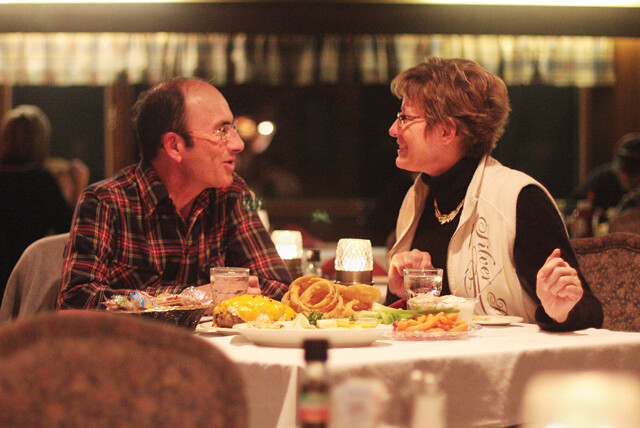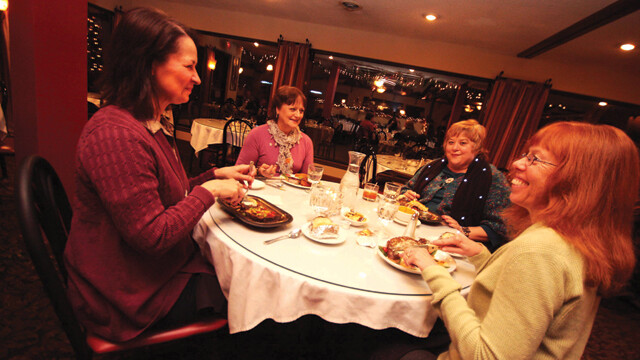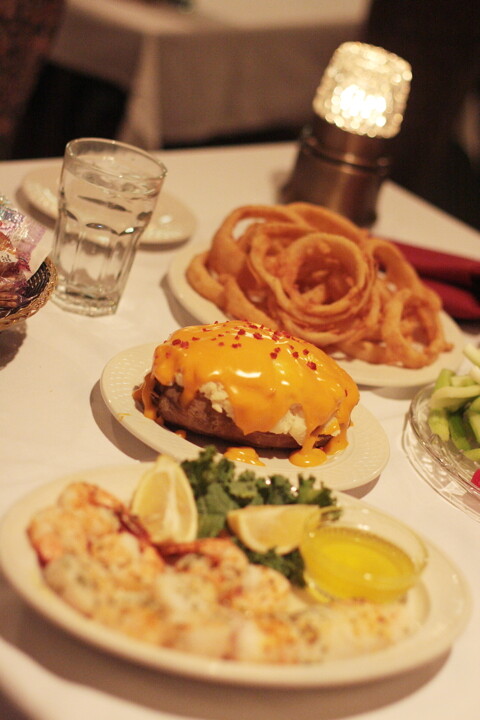The Supper Club
a closer look at one of our most iconic cultural institutions
Kinzy Janssen, photos by Andrea Paulseth |

It’s easy to talk about Supper Clubs in terms of their components. When I asked my coworkers (and then the Supper Club owners themselves) what defines such a restaurant, they pared it down to a checklist of sorts. Is it in the country? Check. Is there a candle on the table, especially one inside a cut glass holder? Check. Low lighting, or a red hue in the walls or carpeting? Yep. Do cocktails reign supreme over beer? Mmmhmm. Is there chicken, prime rib, and seafood? Now you’re getting warmer.
But it’s difficult to define a supper club in overarching terms – to find a way to classify the whole concept rather than just the sum of its parts. But I strongly believe that you can’t just line the walls with dark wood paneling, stock up on creme de menthe, dim the lights, and call it a day. Part of the recipe for a supper club is that intangible quality -- that thing you can’t pierce with a fork or take a picture of.
This restaurant-as-destination attitude is one that simultaneously celebrates Wisconsin’s natural beauty (something we love to do whenever we can) and America’s fascination with driving. It only makes sense that supper clubs were most popular during our automobile and “road culture” heyday – the 1920s to the 1970s.
Peter Gruetzmacher, co-owner of Jake’s Supper Club in Menomonie said, “I think it has a lot to do with establishing coziness, somewhere you can go and have dinner away from everyone’s prying eyes. Perhaps somewhere you can have dinner and conduct business without being interrupted or bothered.”
Lynn McDonough, who has owned Connell’s Supper Club in Chippewa Falls for 23 years (plus Connell’s Club 12 and Connell’s II at the airport), offered the terms “relaxed” and “welcome.” A slower pace is a defining element. “People don’t feel that they need to leave,” he explained, adding that patrons often spend one and a half to two hours conversing over dinner (coupled with before and after-dinner drinks) whereas at a chain restaurant they may feel pressured to leave in under an hour.
Shirley Harpole, owner of Harpole’s Supper Club in Chippewa Falls, is aware that their restaurant classification is a regional oddity. “If you talk to anyone away from Wisconsin, they don’t know what it is. They call it a Super Club,” she laughed. Harpole’s sentiments on the “vibe” of a supper club seemed to bridge the opinions of Gruetzmacher and McDonough. “After being tavern owners, Supper Clubs are much more relaxing ... it’s more relaxing than going to a sports bar. You can go to the bar and talk with a friend without someone hovering over you,” she said.
The bar itself is always integral to a supper club, comprising about half of the puzzle. When I walked into Connell’s on a Friday night in January, I was amused to find the only entrance led straight to the bar – a pink horseshoe-shaped bar that was absolutely bustling. Two bartenders could hardly keep up as they swiped diner’s credit cards and mixed their cocktails.
The owners are the first to tell you that liquor and food really are entwined at a supper club. Gruetzmacher said you can expect to find a bartender who “knows your drink and how to make a Manhattan and an Old Fashioned without pulling out the book. Ice cream drinks are popular – Golden Cadillac, Pink Squirrel, etc.” Then he added, “There is also a good chance grandpa may have a little too much brandy to drive home.”
But the bar isn’t strictly an adult domain. According to Harpole, whole families will often arrive with kids in tow, especially for Tuesday “dollar burger” nights. “In 20 years here I only had to kick out about two people who couldn’t hold their liquor,” she said. “Anyone with a bad mouth or who starts using the F-language – we tell them to knock it off. For the children.”
Though our wandering detour around the bar caused a significant delay in our ability to get seated, we were eventually whisked back to a small table by the faux-snow-lined window.
It was exciting to see generalizations gleaned from my interviews playing out here under the sloping “chalet” roof, crisscrossed with dark exposed beams. Gruetzmacher had said, “You won’t find items labeled ‘low carb’ or ‘low sodium’ on the menu. And all the food is homemade.”
I made discreet notes on a pad of paper as the different rounds of food arrived, knowing I wouldn’t be able to remember everything spread before me on the table.

at High Shores Supper Club.
Within a few minutes, our waitress brought us a “relish” tray with no relish in sight, containing instead baby carrots, celery stalks, green onions, orangey cheese spread, and a large cup of cottage cheese. Next, a linen-lined basket appeared with one plain roll and two sesame/poppyseed rolls inside. Accompanying this was another large basket heaped with individually plastic-wrapped crackers and “breadsticks” in wheat, sesame, onion, and garlic flavors. We each received a classic dinner salad on one of those clear plates with the flower petal designs etched into them; the french dressing came in a paper ketchup cup. And this was before the actual meal.
Because we did not recognize the word, we decided to go with the Lyonnaise. When it showed up, we learned it was a rounded, plate-sized patty of hashbrowns with succulent onions hidden within.
For the two of us, there was a full rack of beef ribs served on what could only have been a serving platter, three fillets of fried haddock with tartar sauce, a pile of green and wax beans and cooked carrots, coleslaw, a fat piece of Texas toast (with the butter soaked in) and a lemon wedge. We could not even consider a Grasshopper afterwards.

Instead we leaned back in our floral brocade upholstered chairs and absorbed the details. A family of snowman cutouts smiled down from one wall. Christmas lights were everywhere. The parking lot and country highway outside were sleepy and snow-covered.
“Often times part of the supper club’s appeal is that it in an out of the way location,” Gruetzmacher said. You would not find one near a mall, in an urban setting, or at the top of a major interstate exit. “It’s a nice, natural-setting type deal,” said McDonough of supper clubs in general. Connell’s Club 12 manager Carol Lien described their particular surroundings: “Club 12 is a mile before Fall Creek and it sits right in front of the farms, the farmland.” And Jake’s is known for its prime position on the shore of a stunningly emerald Tainter Lake.
This restaurant-as-destination attitude is one that simultaneously celebrates Wisconsin’s natural beauty (something we love to do whenever we can) and America’s fascination with driving. It only makes sense that supper clubs were most popular during our automobile and “road culture” heyday – the 1920s to the 1970s.
“While thousands [of supper clubs] likely existed during the automobile heyday from pre-World War II through the 1970s, the Waukesha-based website foodspot.com currently lists some 450 independent Wisconsin restaurants that use the phrase ‘supper club’ in their names, many of which have been around for decades,” writes Brenda K. Bredahl in Wisconsin People & Ideas.
What can these mass closings be attributed to? Since supper clubs serve supper (not lunch or breakfast), McDonough thinks patronage is down because of timing. “Dining is done way earlier, now,” he said. “It used to be busy until midnight. Now, dining at 10pm is unheard of. ... Our time available to serve the people is way down ... down to a four-hour period.”

onion rings, and H20.
At all three Connell’s locations, McDonough has tried to keep savvy and up-to-date with an increasingly health conscious population. Though steaks and prime rib are still popular supper club fare, McDonough said, “We trim them more than we used to. There’s not as much fat on the steaks, now ... but that’s what they used to like to eat, because it had more flavor.”
“Unfortunately I think part of the decline in supper clubs can be attributed to changes in ownership and people taking over supper clubs with little or no experience in the business,” said Gruetzmacher, “... what I like to call retired lawyer syndrome.”
Gruetzmacher purchased the beloved establishment in January of 2009 along with his father Kim after the restaurant closed briefly (to the horror of locals) in 2008. Gruetzmacher earned a degree in Hotel Restaurant Management from UW-Stout and his family already owned three restaurants in Minneapolis prior to taking the reigns of this regional icon, which had been a supper club for 30 years and a restaurant for 60.
Owning a supper club is a demanding job, one that has been compared to farming in terms of physical ties and workload. The lives of Shirley Harpole and her husband were attached quite literally to their establishment – their home sits right next door. “We’ve made our living here for almost 28 years. I work six nights a week. ... There were times when I had to leave because I said ‘I have to go home and wash clothes!’ 99 percent of the time, we’re here,” she said.
The owners are the first to tell you that liquor and food really are entwined at a supper club. Peter Gruetzmacher, owner of Jake’s, said you can expect to find a bartender who “knows how to make a Manhattan and an Old Fashioned without pulling out the book. Ice cream drinks are popular.” Then he added, “There is also a good chance grandpa may have a little too much brandy to drive home.”
McDonough describes the workload in stark terms. “It’s a 20 hour-a-day job,” he said.
“You definitely have to love what you are doing; you work when everyone else is having fun – nights, weekends, and holidays,” said Gruetzmacher.
Harpole’s Supper Club is now for sale (the couple is looking to retire), but the couple has every intention of easing the new owner(s) into the business.
“We want to see the person succeed. If we lived here for a while, I’d help them, and give them recipes if they wanted them,” she said. Her menu strays a bit from classic supper club fare in that they offer homemade Chinese food in addition to Midwestern meat-and-potatoes meals.
“I was going to eliminate it after China Buffet went in. You can’t compete with bucket food. But I make pork balls with real sweet and sour sauce that doesn’t come out of a bucket,” she said. Harpole also makes kim chee – quite a rarity in the Chippewa Falls area. “One man bought a gallon from me,” she said.
The enigmatic supper club hasn’t changed much. Okay, so maybe they trim the fat nowadays. But the whole experience – the peculiar, point-outable puzzle pieces – are the same. Maybe their sameness over the decades is why the term “nostalgia” kept trying to work its way into my definition. (Heck, even the Supper Club brew by Capitol Brewery claims to “hark back to an era when Supper Clubs were In Vogue,” sporting a vintage image and fonts on its label) But it’s not just about re-gaining the cozy feelings of our past. It’s about celebrating a culture that is still thriving.


















